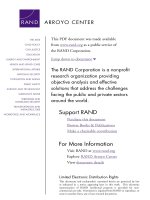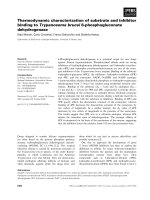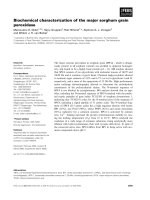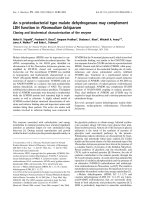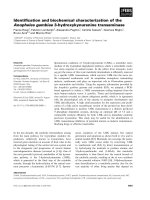Biochemical characterization of the bi lobe complex in trypanosoma brucei
Bạn đang xem bản rút gọn của tài liệu. Xem và tải ngay bản đầy đủ của tài liệu tại đây (4.18 MB, 169 trang )
Biochemical characterization of the bi-lobe
complex in Trypanosoma brucei
LADAN GHEIRATMAND
NATIONAL UNIVERSITY OF SINGAPORE
2013
Biochemical characterization of the bi-lobe
complex in Trypanosoma brucei
LADAN GHEIRATMAND
A THESIS SUBMITTED
FOR THE DEGREE OF DOCTOR OF PHILOSOPHY
DEPARTMENT OF BIOLOGICAL SCIENCES
NATIONAL UNIVERSITY OF SINGAPORE
2013
Declaration
I hereby declare that the thesis is my original work and it has been
written by me in its entirety. I have duly acknowledged all the sources
of information which have been used in this thesis.
This thesis has also not been submitted for any degree in any
university previously.
____________________________
Ladan Gheiratmand
August 2013
I
Acknowledgements
Many many people made it possible for me to get to where I am today
in my academic career.
My deep and sincere thanks go to my supervisor Dr. Cynthia He for
her generous supports and guidance throughout my work. I am
indebted to her for all the training and advice. Her faith in my abilities
and her constant encouragement as well as her kindness and patience
have had great impact on shaping my character as an independent
researcher.
Cynthia, you were a lot more than just a supervisor to me. I’ll never
forget what you did for me in the most difficult days of my life in
Singapore. Your help and emotional support made me very determined
in achieving what I was always looking for.
I would like to thank the past and present members of Cynthia’s lab
who have made the lab a cheerful and friendly environment to work in.
I would like to thank Zhou Qing and Shi Jie for all the techniques
they’ve taught me when I joined the lab. I’m thankful to Zhang Yu, Sun
Ying, Wang Min, Feng Jun, Shen Qian and Shima for their scientific
discussions, support and friendship during these years. A big thank
you to Dulani and Foong Mei for keeping the lab such a neat and
organized place that anybody would love to work in.
My special thanks go to Omar, Anais and Fern who have always been
there for me in sadness and happiness. I will never forget our group
lunches, the discussions and all the laughter and fun we had together.
II
Omar, the office would have been a totally different place without you!
God knows how many hours of argument we have had over my
project, papers, science, English writing and life. I owe a big thank you
to our colleagues in the office who patiently put up with our noise!
Anais, I’ve learned a lot from you. You were always open to any
question and discussion. I’ve enjoyed every moment of working and
communicating with you. We have laughed and cried a lot together in
the ups and downs of our lives. You mean a lot to me and I’ll truly miss
you and the moments we had together.
I owe all my Iranian friends in Singapore for their kindness, love and
support. I am truly thankful to Pooneh, Hosein, Azadeh, Mahmood,
Neda and Ehsan and many more who made Singapore feel like home
for me.
Although he is not among us anymore but I’d like to say thank you from
the bottom of my heart to Arash, my love, who believed in me,
supported me and gave me the opportunity of stepping into the way I
was always hoping for.
Last but not least, I would like to show my deepest gratitude to my
parents for their unlimited love, support and encouragement
throughout my life. Without them I could not have accomplished this
pioneering step of my life.
I would like to dedicate this thesis to Arash and my parents.
III
Table of Contents
Chapter 1- Introduction 1
1.1 Organelle inheritance in eukaryotes 1
1.2 Trypanosomes, an overview 4
1.2.1 Trypanosoma brucei 4
1.2.2 T.brucei life cycle 5
1.2.3 T.brucei molecular genetics 7
1.2.4 T.brucei cell architecture 7
1.2.5 T.brucei cell cycle 12
1.3 Bi-lobe structure 16
1.3.1 Bi-lobe proteins 18
1.3.2 Bi-lobe’s function and significance 23
Chapter 2- Materials and methods 25
2.1 Cell lines 25
2.2 Plasmid construction and transfection 25
2.3 Antibodies 28
2.4 Preparation of flagellum and flagellar complex 31
2.5 iTRAQ labeling and liquid chromatography 32
2.6 Cell fractionation 32
2.7 Immunoisolation of the bi-lobe 34
IV
2.8 LC-MS/MS and data analysis 36
2.9 Immunofluorescence microscopy 36
2.10 Cell motility assay 37
2.11 Electron microscopy 38
2.11.1 TEM on extracted cytoskeleton 38
2.11.2 Immuno-EM on core cytoskeleton 39
2.11.3 Immuno-cryoEM 39
2.11.4 Scanning electron microscopy (SEM) 40
2.12 Cell growth assays 40
Chapter 3- Results 41
3.1 Purification of T.brucei flagella 41
3.2 Comparative proteomics using iTRAQ 43
3.3 TbLRRP1, a new bi-lobe candidate 44
3.4 TbLRRP1 localizes to the bi-lobed structure 46
3.5 Functional studies on TbLRRP1 48
3.5.1 TbLRRP1 is essential for parasite growth 48
3.5.2 The effects of TbLRRP1 RNAi on cell division 49
3.5.3 The effects of TbLRRP1 RNAi on cell motility 50
3.5.4 The effects of TbLRRP1 RNAi on kinetoplast division 51
3.5.5 The effects of TbLRRP1 RNAi on Golgi duplication 53
3.5.6 The effects of TbLRRP1 RNAi on FAZ formation 54
V
3.5.7 The effects of TbLRRP1 RNAi on FPC 57
3.6 Cell fractionation by differential centrifugation 60
3.7 Immunoisolation of the bi-lobe and associated structures 62
3.8 Identification of bi-lobe associated proteins by LC/MS-MS 65
3.9 TbSpef1 localizes to the MtQ region between the basal
bodies and the bi-lobe 75
3.10 Functional studies on TbSpef1 79
3.10.1 TbSpef1 is essential for procyclic cell survival 80
3.10.2 TbSpef1-RNAi affects the duplication / segregation of
different organelles 82
3.11 p197, a TAC protein 85
3.12 P197 RNAi affects the kinetoplast segregation 87
3.13 FP45 encircles the flagellar pocket 90
3.14 BB50 localizes to the basal bodies 93
3.15 Tb927.9.11830 moves between the basal bodies and the bi-
lobe ………………………………………………………………… 94
3.16 Tb927.7.2190 and Tb927.3.640 localize to the ER 97
3.16.1 Tb927.7.2190 97
3.16.2 Tb927.3.640 98
3.17 Tagged proteins with cytoplasmic localization 100
Chapter 4- Discussion 102
VI
4.1 TbLRRP1, an exclusive bi-lobe protein 102
4.2 TbLRRP1 plays an essential role in organelle duplication
and cell division 104
4.3 Structural complexity of the bi-lobe 106
4.4 Characterization of bi-lobe associated proteins reveals
extensive connection of bi-lobe to other cellular structures 108
4.5 TbSpef1 stabilizes the MtQ 110
4.6 Bi-lobe is interconnected with other single-copy organelles
…………………………………………………………………114
4.7 Future directions 117
4.7.1 Further characterization of TbLRRP1 and its binding
partners 117
4.7.2 TbSpef1 molecular mechanisms 117
VII
Summary
Trypanosoma brucei, a unicellular parasite, contains several single-
copied organelles that duplicate and segregate in a highly co-ordinated
fashion during the cell cycle. In the procyclic stage of the parasite, a bi-
lobed structure is found adjacent to the single ER exit site and Golgi
apparatus near the flagellar pocket, which is a surface membrane
invagination dedicated to endocytic and exocytic activities. Duplication
and segregation of the bi-lobe occur co-ordinated with other single
copied structures but little is known about their associations and the
mechanisms.
Up to the date of starting this study, only four proteins were known to
localize to the bi-lobe. In search for new bi-lobe proteins, comparative
proteomics was performed on the extracted flagellar complexes
(including the flagellum and flagellum-associated structures such as
the basal bodies and the bi-lobe) and purified flagella. A leucine-rich
repeats containing protein, TbLRRP1, was characterized as a new bi-
lobe component. The anterior part of the TbLRRP1-labeled bi-lobe is
adjacent to the single Golgi apparatus, and the posterior side is tightly
associated with the flagellar pocket collar marked by TbBILBO1.
Inducible depletion of TbLRRP1 by RNA interference inhibited
duplication of the bi-lobe as well as the adjacent Golgi apparatus and
flagellar pocket collar. Formation of a new flagellum attachment zone
and subsequent cell division were also inhibited, suggesting a central
role for bi-lobe in Golgi, flagellar pocket collar and flagellum attachment
zone biogenesis.
VIII
To further understand the bi-lobe and its association with other
organelles, TbLRRP1 was used as a bi-lobe specific marker for
immunoisolation of the bi-lobe complex. Among >70 candidates
obtained from MS analyses of the immunoisolated bi-lobe, this study
focused on four candidates: BB50, FP45, p197 and TbSpef1, which
included both soluble and cytoskeleton-associated components that
respectively localized to the basal bodies, the flagellar pocket, a
tripartite attachment complex (TAC) linking the basal bodies to the
kinetoplast, and a segment of microtubule quartet linking the FPC and
bi-lobe to the basal bodies. These proteins provided new markers to
follow T. brucei organelle biogenesis and inheritance. They also
confirmed the presence of an extensive connection among the single-
copied organelles in T. brucei, a strategy employed by the parasite for
orderly organelle assembly and inheritance during the cell cycle.
IX
List of tables
Table 2-1. List of vectors used in this study. 26
Table 2-2. List of constructs generated in this study. 27
Table 2-3. List of antibodies used in this study. 29
Table 3-1. Flagellar length, FAZ length, kinetoplast and nucleus
migration in binucleated cells. 56
Table 3-2. List of protein candidates identified by LC/MS-MS with at
least 2 hits. 68
Table 3-3. Summary of the proteins tagged and further studied 73
X
List of figures
Fig. 1-1. The life cycle of T.brucei in mammals and tsetse fly 6
Fig. 1-2. Schematic diagram of the TAC structure. 9
Fig. 1-3. Flagellum of T.brucei 10
Fig. 1-4. FAZ and flagellum structure. 11
Fig. 1-5. Ultrastructural features of T.brucei. 12
Fig. 1-6. Procyclic T. brucei cell cycle revealed by TEM. 15
Fig. 1-7. 20H5 labels both the basal bodies and a bi-lobed structure in
T.brucei. 16
Fig. 1-8. Schematic representation of T.brucei cell cycle. 17
Fig. 1-9. TbCentrins2 and 4 overlap on the bi-lobe during the cell
cycle. . 20
Fig. 2-1. Flowchart showing the cell fractionation by differential
centrifugation. 33
Fig. 2-2. Flowchart of the bi-lobe immunoisolation process. 35
Fig. 3-1. Purification of the flagellum and flagellar complex for
comparative proteomics 42
Fig. 3-2. Purification of flagellar complex and detached flagellum. 43
Fig. 3-3. Domain organization of TbLRRP1. 45
Fig. 3-4. YFP-TbLRRP1 is present on a bi-lobed / looped structure 45
Fig. 3-5. Characterization of TbLRRP1 antibody 46
XI
Fig. 3-6. TbLRRP1 is a bi-lobe protein. 47
Fig. 3-7. TbLRRP1 RNAi affects the cell growth. 49
Fig. 3-8. TbLRRP1-RNAi inhibited kinetoplast division and cytokinesis
50
Fig. 3-9. TbLRRP1 RNAi leads to defects in motility. 51
Fig. 3-10. TbLRRP1-RNAi inhibited segregation, but not duplication of
basal bodies and flagellum. 52
Fig. 3-11. TbLRRP1-RNAi inhibited duplication of bi-lobe and Golgi. 54
Fig. 3-12. TbLRRP1-RNAi inhibited the formation of new FAZ. 55
Fig. 3-13. Electron microscopic analyses of TbLRRP1-RNAi mutants.
57
Fig. 3-14. TbLRRP1-RNAi inhibits FPC duplication. 59
Fig. 3-15. Cell fractionation 61
Fig. 3-16. Fluorescence microscopy of intact bi-lobe structure in P2. 62
Fig. 3-17. Immunoisolation of the TbLRRP1- labeled bi-lobe. 63
Fig. 3-18. Biochemical analysis of the immunoisolated bi-lobe. 65
Fig. 3-19. YFP-TbSpef1 localization during the cell cycle. 76
Fig. 3-20. Characterization of anti-TbSpef1 antibody. 79
Fig. 3-22. TbSpef1 is essential for procyclic cell survival. 81
Fig. 3-23. TbSpef1-RNAi has distinct effects on the duplication of
different organelles. 83
XII
Fig. 3-24. TbSpef1-depletion does not affect basal body duplication,
maturation and rotation. 84
Fig. 3-25. TbSpef1 depletion inhibits new MtQ assembly. 85
Fig. 3-26. p197 maps to a region between the basal bodies and the
kinetoplast DNA. 86
Fig. 3-27. p197-RNAi leads to unequal kinetoplast segregation. 88
Fig.3-28. P197-RNAi does not affect basal bodies and flagella
duplication/segregation. 91
Fig. 3-31. FP45 outlines the flagellar pocket. 91
Fig. 3-32. FP45 is a soluble protein expressed in both procyclic and
bloodstream forms. 92
Fig. 3-33. Anti-FP45 localizes to the flagellar pocket in BSF cells. 93
Fig. 3-34. BB50 localizes to the basal bodies. 94
Fig. 3-35. Localization of YFP-2950. 95
Fig. 3-36. YFP-2950 labels a dot near the basal bodies. 96
Fig. 3-37. 2190-YFP overlaps with the ER lumenal marker BiP. 98
Fig. 3-38. Tb927.3.640 localizes to the ER. 99
Fig. 3-39. Tb927.3.640 and Tb927.7.2190 are soluble. 99
Fig. 3-40. YFP-tagged Tb927.11.11460, Tb927.8.1740 and
Tb927.5.289b demonstrated cytoplasmic localization 101
Fig. 4-1. A continuous cytoskeletal network tethers the basal bodies to
the FPC/bi-lobe. 115
XIII
List of publications
• Ladan Gheiratmand, Anais Brasseur, Qing Zhou and Cynthia Y.
He, Biochemical characterization of the bi-lobe revealed a
continuous structural network linking the bi-lobe to other single-
copied organelles in Trypanosoma brucei. J Biol Chem. 2013, Feb
1; 288 (5):3489-99. PMID: 23235159
• Wang Min, Ladan Gheiratmand and Cynthia Y. He, An interplay
between Centrin2 and Centrin4 on the bi-lobed structure in
Trypanosoma brucei. Mol. Microbiol. 2012, March; 83(6):1153-61.
PMID: 22324849
• Alexey Y. Koyfman, Michael F. Schmid, Ladan Gheiratmand,
Caroline J. Fu, Htet A. Khant, Dandan Huang, Cynthia Y. He and
Wah Chiu, Cryo- ET structure of Trypanosoma brucei flagellum
accounts for its bihelical motion, PNAS 2011, July 5; 108(27):11105-
8. PMID: 21690369
• Qing Zhou
*
, Ladan Gheiratmand
*
, Yixin Chen, Teck Kwang Lim,
Binghai Liu,
Jun Zhang, Shaowei Li, Ningshao Xia, Qingsong Lin
and Cynthia Y. He, A comparative proteomic analysis reveals a new
bi-lobe protein required for bi-lobeuplication and cell division in
Trypanosoma brucei, Plos One 2010, March15; 5(3): e9660. PMID:
20300570
*Equal contribution
- Not all the works I did for these papers is included in this thesis.
XIV
List of symbols
HAT Human African Trypanosomiasis
PCF Procyclic form
BSF Bloodstream form
FP Flagellar Pocket
FPC Flagellar Pocket Collar
FC Flagella connector
MT Microtubule
FAZ Flagellum attachment zone
MtQ Microtubule quartet
pMtQ proximal MtQ
PCR Polymerase chain reaction
RNAi RNA interference
aa Aminoacid
Spef Sperm flagellar protein
CLAMP Calponin-homology and microtubule-associated
EB End-binding
BB Basal body
pBB Pro basal body
LRRP Leucine-rich repeat protein
PLK Polo-like kinase
SDS-
PAGE
Sodium dodecyl sulphate polyacrylamide gel
Duf Domain of unknown function
CH
Calponin homology domain
BRCT Brca1 C-Terminal
PCP Planar cell polarity
Bla Blasticidin
Phleo Phleomycin
Tet Tetracycline
XV
kDNA Kinetoplast DNA
CDS Coding sequence
C-
ter
C-terminal
N-
ter
N-terminal
UTR Untranslated region
EM Electron microscope
IEM Immuno electron microscopy
TEM Transmission electron microscopy
SEM Scanning electron microscope
PFA Paraformaldehyde
IF Immunofluorescence
IB
Immunoblot
bp Base pair
DAPI 4,6- diamidino-2- phenylindole
RT Room temperature
kDa Kilodalton
1
Chapter 1- Introduction
1.1 Organelle inheritance in eukaryotes
Eukaryotic cells contain extensive internal membranes that enclose
specific regions and separate them from the cytoplasm. These
membrane-bound specialized subcellular structures are called
organelles. Each organelle has a distinct size, role and copy number
that reflect its function (Fagarasanu et al., 2010; Warren and Wickner,
1996). Cells contain double membrane organelles such as nuclei,
mitochondria and chloroplasts, as well as single membrane-bound
organelles including endoplasmic reticulum (ER), Golgi, peroxisome
and lysosomes or vacuoles to name some (Imoto et al., 2011; Kuroiwa,
2010). However, some organelles like centrosomes, composed of
centrioles embedded in the pericentriolar material (PCM), and basal
bodies lack membrane (Loncarek and Khodjakov, 2009; Sun and
Schatten, 2007).
Faithful duplication and segregation of subcellular organelles are
essential features of the eukaryotic cell cycle and are regulated via a
precisely controlled spatio-temporal sequence of events. Depending on
the morphology, copy number, and biological functions, different
organelles may employ different mechanisms to ensure faithful
replication and partitioning into dividing cells. Molecular mechanisms
that allow orderly organelle inheritance are increasingly evident in
animal, plant, yeast and other eukaryotic cells (Fagarasanu and
2
Rachubinski, 2007; Imoto et al., 2011; Lowe and Barr, 2007; Sheahan
et al., 2007).
Nuclear inheritance that occurs by DNA duplication followed by its
segregation on the mitotic spindle is a conserved, well organized
mechanism in most eukaryotes. Other DNA containing organelles like
mitochondria and chloroplast frequently go under templated duplication
to transfer their genetic source and membranes to their daughters.
Several pathological defects including liver disease, muscular
dystrophy, Huntington disease and cancer are associated with
alterations in mitochondrial distribution and morphology (Chaturvedi
and Beal, 2012; Nishino et al., 1998; Yaffe, 1999).
Centrosomes (basal bodies, spindle pole bodies) are not membrane-
bound, neither do they contain DNA. Centrosomes duplicate in S
phase and their duplication is tightly regulated with the cell cycle to
limit it to once per cycle. Centrosomes are important for several
biological processes including cilia / primary cilia formation (Hatch and
Stearns, 2010), pronuclear migration in zygotes and defining polarity in
C. elegans (Cowan and Hyman, 2004). New centrioles can be
generated either by duplication of the mother centriole or denovo
assembly depending on the cell type and organism (Loncarek and
Khodjakov, 2009; Szollosi and Ozil, 1991; Vladar and Stearns, 2007).
Lacking enough centrosomes or having too many of them, affects the
centrosome dependant functions leading to developmental defects,
genome instability and cancer (Basto et al., 2006; Ganem et al., 2009;
Hatch and Stearns, 2010; Silkworth et al., 2009; Stevens et al., 2007),
3
further emphasizing the importance of maintaining the right number of
centrosomes.
Many studies on the biogenesis and inheritance mechanisms of single
membrane-bound organelles were performed in the budding yeast
(Saccharomyces cerevisiae) due to its polarized growth and
asymmetric cell division. Early Golgi is produced de novo in the buds
while late Golgi can be either made de novo or transferred from the
mother (Pon, 2008; Reinke et al., 2004). Golgi secretory vesicles
containing compartments of Golgi and ER, mitochondria, peroxisomes
and vacuoles travel to the bud using a class V myosin motor moving
on the actin cables (Fagarasanu et al., 2010; Pon, 2008; Pruyne et al.,
2004). However, the nucleus and its linked ER use a microtubule-
based mechanism of inheritance (Fagarasanu et al., 2010;
Fehrenbacher et al., 2002). Generally speaking, cytoskeletal
components, such as actins and microtubules, are critically involved in
precise positioning and inheritance of many organelles in different
organisms (Drubin et al., 1993; Gull, 2001; Striepen et al., 2000; Yaffe,
1999).
Whereas the duplication and division of certain organelles is relatively
well understood, how different organelles are coordinatedly regulated
during biogenesis and inheritance remains less investigated. Simple
eukaryotes containing multiple single-copied organelles are good
models for studying organelle inheritance and mechanisms underlying
their coordination. One such model used in this study is Trypanosoma
brucei.
4
1.2 Trypanosomes, an overview
Organisms of the Trypanosoma species belong to the taxon
kinetoplastida, a group of flagellated protozoa that are defined by a
unique network of condensed mitochondrial DNA known as kinetoplast
(Stuart et al., 2008). Trypanosoma brucei, Trypanosoma cruzi and
Leishmania major (aka the TriTryps) share many common features at
both morphological and genomic level (Berriman, 2005), and are the
best studied trypanosomatids. These species are among the earliest
divergent eukaryotes to have emerged on earth around 300 million
years ago (Dacks and Doolittle, 2001; Simpson et al., 2006). Despite
their great similarity, each member of the TriTryps is responsible for a
distinct human disease.
1.2.1 Trypanosoma brucei
Trypanosoma brucei is an extracellular single-celled parasite causing
human African trypanosomiasis (HAT), a lethal disease if left
untreated. Transmitted by tsetse fly (Glossina genus), HAT is endemic
to 36 countries of the sub-Saharan region, putting ~60 million people at
risk and leading to 50000-70000 deaths per year (Matthews, 2005).
In addition to HAT, African trypanosomes also cause Nagana, the
animal form of trypanosomiasis, thus imposing a great economical
burden on the sub-Saharan Africa. HAT has two pathological phases
and depending on the involved subspecies (T.brucei gambiense or
T.brucei Rhodesiense), a chronic or acute infection showing different
signs and symptoms may occur. Irregular fevers, chancre, occasional
5
headaches, pruritus and development of adenopathies are among the
symptoms of the first stage of the disease. Following penetration
through the blood-brain barrier, the parasite invades the central
nervous system (CNS) and patients enter the second phase of disease
that is characterized by neurological disorders and sleeping
disturbance, eventually leading to coma and death (Brun et al., 2010;
Simarro et al., 2008).
Vaccine is not available. Existing drugs are old, toxic and known to
cause serious side effects. It is therefore pertinent to further study the
basic biology of this neglected pathogen and uncover new drug
targets.
1.2.2 T.brucei life cycle
T.brucei takes different developmental forms during its alternating life
cycle between and within the insect and mammalian hosts (Fig. 1-1).
Procyclic form found in the midgut of the fly vector and the
bloodstream form living in the mammalian host are the two proliferative
forms that can be cultured in vitro. Switching between these two cycles
requires environmental and nutrient alternations, and the differentiation
processes are accompanied by changes in gene expression, cell
architecture and primary metabolism (Field and Carrington, 2009;
Matthews, 2005).
6
Fig. 1-1. The life cycle of T.brucei in mammals and tsetse fly.
Bloodstream, procyclic and epimastigote are the proliferative (P) forms while
short stumpy and metacyclic are the quiescent (Q) forms of the parasite in
different hosts. This study focused on the procyclic form, which proliferates in
the midgut of tsetse fly. Adapted and modified from (Hee Lee et al., 2007).
Upon infection by the bite of a tsetse fly carrying the infectious
metacyclic form parasite, dividing long slender form parasites first
emerge in the bloodstream and tissues of the infected mammals.
Primarily by sequential expression of their distinct variant surface
glycoproteins (VSGs)(Cross, 1978), these parasites escape the host
immune system. At high density, some long slender form cells continue
to invade the central nervous system (CNS) and some stop dividing
and differentiate to the non-dividing short stumpy form to pre-adapt
before entering the fly vector. After transmission to the insect vector
mid gut, a rapid differentiation to the proliferative procyclic form occurs.
Parasites differentiate to multiple forms before they generate the
7
mammalian infective growth arrested metacyclic form residing in the
salivary glands of the tsetse fly. The parasites life cycle will be
completed by entering the mammalian host via the fly bite (Field and
Carrington, 2009; Matthews et al., 2004).
1.2.3 T.brucei molecular genetics
In addition to its biomedical importance, T.brucei has also served as a
simple eukaryotic model system to study many basic molecular and
cellular mechanisms. T. brucei genome is fully sequenced (Berriman,
2005), and the parasite is genetically tractable. Generating knockouts,
tagging endogenous genes with various reporters through homologous
recombination, inducible ectopic expression and RNAi (to specifically
knock down gene expression), and stable constitutive overexpression
can all be conducted on T.brucei (Shen et al., 2001; Wang, 2000).
Recent production of large scale RNAi libraries offers further
opportunities for studying the potential interesting mutants (Alsford et
al., 2011; Morris et al., 2002; Schumann Burkard et al., 2011).
1.2.4 T.brucei cell architecture
T.brucei, ~10-15µm in length (including the flagellum) and 3-6 µm in
width, has a defined cell shape due to the support of a stable polarized
microtubular corset (subpellicular microtubules) (Robinson et al., 1995;
Sherwin and Gull, 1989). Minus ends of these MTs are located at the
anterior side of the cell, and their plus ends lie at the posterior region
(Gull, 1999; Robinson et al., 1995) (Fig. 1-4, Fig. 1-5).


